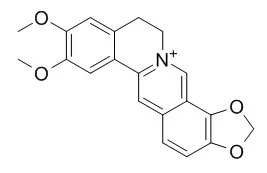| In vivo: |
| Eur J Pharmacol. 2016 Mar 5;774:1-9. | | Epiberberine reduces serum cholesterol in diet-induced dyslipidemia Syrian golden hamsters via network pathways involving cholesterol metabolism.[Pubmed: 26593426 ] | This study aimed to evaluate the cholesterol-lowering effect of Epiberberine in dyslipidemia Syrian golden hamsters induced by high fat and high cholesterol (HFHC) diet and its regulation mechanism on some key genes involved in cholesterol metabolism.
METHODS AND RESULTS:
Hamsters were divided into six groups: normal control group (NC), HFHC group, simvastatin (Sim) and three doses of Epiberberine group. The body weight, organs weight and serum lipid levels, as well as total cholesterol (TC) and total bile acids (TBA) levels in liver and feces were determined. Furthermore, the antidyslipidemia effect of Epiberberine on key genes involved in cholesterol biosynthesis, uptake, conversion and elimination such as 3-hydroxy-3-methylglutaryl-CoA reductase (HMGCR), low density lipoprotein receptor (LDL receptor), 7-alpha-hydroxylase (CYP7A1) and apical sodium dependent bile acid transporter (ASBT) were investigated. The results showed that Epiberberine at high dosage significantly reduced serum TC, low density lipoprotein cholesterol (LDL-c) and TBA levels by 20.2%, 22.3% and 43.8%, respectively, and increased TBA and TC levels in feces. Epiberberine inhibited HMGCR mRNA and protein expressions and slightly reduced the protein level of ASBT, as well as dramatically up-regulated mRNA and protein expressions of CYP7A1 and LDL receptor.
CONCLUSIONS:
These findings suggested that the antidyslipidemia effects of Epiberberine can be achieved via inhibiting the synthesis of cholesterol, promoting the uptake and conversion of TC in liver and increasing the excretion of TC and TBA in feces. Thus, Epiberberine should be considered as one of the promising natural drugs for the treatment of dyslipidemia. | | Biol Pharm Bull. 2009 Aug;32(8):1433-8. | | Anti-Alzheimer and antioxidant activities of Coptidis Rhizoma alkaloids.[Pubmed: 19652386] | Coptidis Rhizoma and its isolated alkaloids are reported to possess a variety of activities, including neuroprotective and antioxidant effects.
METHODS AND RESULTS:
Thus, the anti-Alzheimer and antioxidant effects of six protoberberine alkaloids (berberine, palmatine, jateorrhizine, Epiberberine, coptisine, and groenlandicine) and one aporphine alkaloid (magnoflorine) from Coptidis Rhizoma were evaluated via beta-site amyloid precursor protein (APP) cleaving enzyme 1 (BACE1), acetylcholinesterase (AChE), and butyrylcholinesterase (BChE) assays, along with peroxynitrite (ONOO(-)) scavenging and total reactive oxygen species (ROS) inhibitory assays. Six protoberberine alkaloids exhibited predominant cholinesterases (ChEs) inhibitory effects with IC(50) values ranging between 0.44-1.07 microM for AChE and 3.32-6.84 microM for BChE; only Epiberberine (K(i)=10.0) and groenlandicine (K(i)=21.2) exerted good, non-competitive BACE1 inhibitory activities with IC(50) values of 8.55 and 19.68 microM, respectively. In two antioxidant assays, jateorrhizine and groenlandicine exhibited significant ONOO(-) scavenging activities with IC(50) values of 0.78 and 0.84 microM, respectively; coptisine and groenlandicine exhibited moderate total ROS inhibitory activities with IC(50) values of 48.93 and 51.78 microM, respectively. These results indicate that Coptidis Rhizoma alkaloids have a strong potential of inhibition and prevention of Alzheimer's disease (AD) mainly through both ChEs and beta-amyloids pathways, and additionally through antioxidant capacities. In particular, groenlandicine may be a promising anti-AD agent due to its potent inhibitory activity of both ChEs and beta-amyloids formation, as well as marked ONOO(-) scavenging and good ROS inhibitory capacities.
CONCLUSIONS:
As a result, Coptidis Rhizoma and the alkaloids contained therein would clearly have beneficial uses in the development of therapeutic and preventive agents for AD and oxidative stress-related disease. |
|






 Cell. 2018 Jan 11;172(1-2):249-261.e12. doi: 10.1016/j.cell.2017.12.019.IF=36.216(2019)
Cell. 2018 Jan 11;172(1-2):249-261.e12. doi: 10.1016/j.cell.2017.12.019.IF=36.216(2019) Cell Metab. 2020 Mar 3;31(3):534-548.e5. doi: 10.1016/j.cmet.2020.01.002.IF=22.415(2019)
Cell Metab. 2020 Mar 3;31(3):534-548.e5. doi: 10.1016/j.cmet.2020.01.002.IF=22.415(2019) Mol Cell. 2017 Nov 16;68(4):673-685.e6. doi: 10.1016/j.molcel.2017.10.022.IF=14.548(2019)
Mol Cell. 2017 Nov 16;68(4):673-685.e6. doi: 10.1016/j.molcel.2017.10.022.IF=14.548(2019)